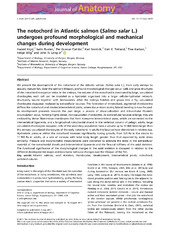| dc.contributor.author | Kryvi, Harald | |
| dc.contributor.author | Rusten, Iselin | |
| dc.contributor.author | Fjelldal, Per Gunnar | |
| dc.contributor.author | Nordvik, Kari | |
| dc.contributor.author | Totland, Geir Kåre | |
| dc.contributor.author | Karlsen, Tine Veronica | |
| dc.contributor.author | Wiig, Helge | |
| dc.contributor.author | Long, John H. | |
| dc.date.accessioned | 2018-05-03T12:31:17Z | |
| dc.date.available | 2018-05-03T12:31:17Z | |
| dc.date.issued | 2017-11 | |
| dc.Published | Kryvi H, Rusten, Fjelldal PG, Nordvik K, Totland G, Karlsen TV, Wiig H, Long JH. The notochord in Atlantic salmon (Salmo salar L.) undergoes profound morphological and mechanical changes during development. Journal of Anatomy. 2017;231(5):639-654 | eng |
| dc.identifier.issn | 0021-8782 | en_US |
| dc.identifier.issn | 1469-7580 | en_US |
| dc.identifier.uri | https://hdl.handle.net/1956/17683 | |
| dc.description.abstract | We present the development of the notochord of the Atlantic salmon (Salmo salar L.), from early embryo to sexually mature fish. Over the salmon's lifespan, profound morphological changes occur. Cells and gross structures of the notochord reorganize twice. In the embryo, the volume of the notochord is dominated by large, vacuolated chordocytes; each cell can be modeled as a hydrostat organized into a larger cellular‐hydrostat network, structurally bound together with desmosomes. After the embryo hatches and grows into a fry, vacuolated chordocytes disappear, replaced by extracellular lacunae. The formation of mineralized, segmental chordacentra stiffens the notochord and creates intervertebral joints, where tissue strain during lateral bending is now focused. As development proceeds towards the parr stage, a process of devacuolization and intracellular filament accumulation occur, forming highly dense, non‐vacuolated chordocytes. As extracellular lacunae enlarge, they are enclosed by dense filamentous chordocytes that form transverse intervertebral septa, which are connected to the intervertebral ligaments, and a longitudinal notochordal strand. In the vertebral column of pelagic adults, large vacuolated chordocytes reappear; cells of this secondary population have a volume up to 19 000 times larger than the primary vacuolated chordocytes of the early notochord. In adults the lacunae have diminished in relative size. Hydrostatic pressure within the notochord increases significantly during growth, from 525 Pa in the alevins to 11 500 Pa in adults, at a rate of increase with total body length greater than that expected by static stress similarity. Pressure and morphometric measurements were combined to estimate the stress in the extracellular material of the notochordal sheath and intervertebral ligaments and the flexural stiffness of the axial skeleton. The functional significance of the morphological changes in the axial skeleton is discussed in relation to the different developmental stages and locomotor behavior changes over the lifespan of the fish. | en_US |
| dc.language.iso | eng | eng |
| dc.publisher | Wiley | en_US |
| dc.rights | Attribution CC BY-NC-ND | eng |
| dc.rights.uri | http://creativecommons.org/licenses/by-nc-nd/4.0/ | eng |
| dc.subject | Atlantic salmon | eng |
| dc.subject | axial skeleton | eng |
| dc.subject | chordocytes | eng |
| dc.subject | development | eng |
| dc.subject | intervertebral joints | eng |
| dc.subject | Notochord | eng |
| dc.subject | vertebral column | eng |
| dc.title | The notochord in Atlantic salmon (Salmo salar L.) undergoes profound morphological and mechanical changes during development | en_US |
| dc.type | Peer reviewed | |
| dc.type | Journal article | |
| dc.date.updated | 2018-01-02T11:19:26Z | |
| dc.description.version | publishedVersion | en_US |
| dc.rights.holder | Copyright 2017 The Author(s) | en_US |
| dc.identifier.doi | https://doi.org/10.1111/joa.12679 | |
| dc.identifier.cristin | 1528542 | |
| dc.source.journal | Journal of Anatomy | |

